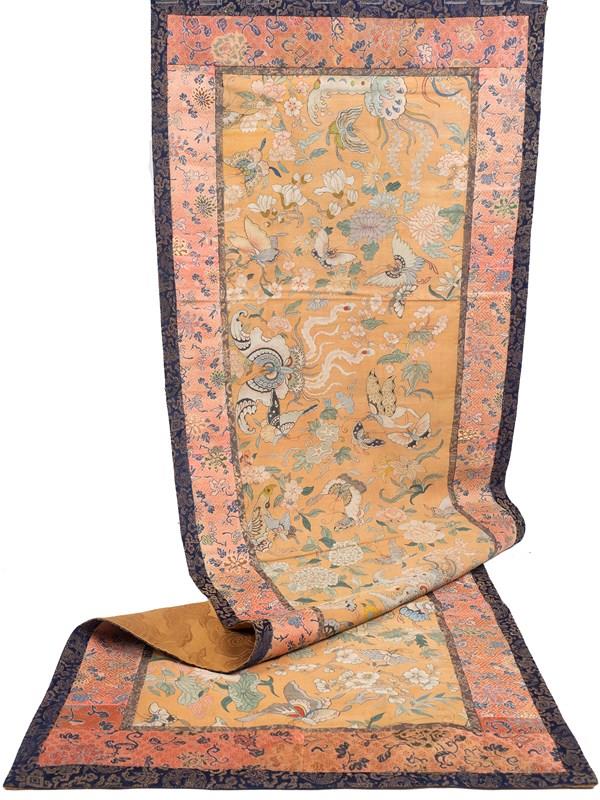Decorative Collective - www.decorativecollective.com
Sellers's Details
ROCHE COWARD
Tel:
Email: [email protected]
https://www.decorativecollective.com/dealers/roche-cowardItem Details
Exceptional in both quality and condition, with superb provenance to cap it off. This museum quality Chinese Kesi tapestry was likely created in Wenzhou, Zhenjiang province and is circa mid to late 18th century.
The intricate and beautifully woven design features a host of charming and lavishly drawn butterflies among flowers on a pinky peach ground. The kesi panel is framed by ornate silk brocade in shades of pink and dark blue, which perfectly compliment the palette of the tapestry. The reverse features a fine damask silk panel in a monochrome golden/brown, woven with a dense cloud scroll motif, which probably dates to the mid-Ming dynasty, circa 15th/16th century. 154cm x 53cm (60.6 x 20.8 inches)
Condition: Excellent overall condition. The kesi panel exhibits very little soiling, minimal creasing, and only a few loose threads. It must be regarded as exceedingly rare in such a pristine state of preservation. The reverse panel shows some old wear, some losses, soiling, and discolouration, yet remains in exceptional condition considering its probable age of over 500 years. (Important Note: you will see from the images and video a couple of slits where for example the edge of a wing meets the peach ground. These slits are a characteristic feature of the Kesi technique, arising from the way different colours are woven, not age related damage. In kesi, each colour area is created with a separate bobbin, and when one colour ends and another begins, a small slit is left between them. These slits, though a source of fragility, are a defining element of the kesi style.) Please see extra images here for full condition.
Provenance: From the private collection of Suzanne Braley, thence by descent. Suzanne Henriette Marguerite Braley (1893-1970) was a banker based in Monte Carlo, Monaco. She lived in Shanghai between around 1910 and 1920, where she collected Chinese antiques.
The Hundred Butterflies motif: This was a highly popular decorative theme in Imperial art, textiles, porcelain, and lacquerware in China during the Qing dynasty. Carrying deep symbolic meaning, it reflects auspiciousness, longevity, prosperity, and beauty. The motif was particularly favoured in the Qianlong Emperor's reign (1735–1796), a period known for artistic flourishing and intricate decorative designs.
Kesi Tapestry: Kesi means ‘cut silk’, and derives from the visual illusion of cut threads that is created by distinct, unblended areas of colour, as the weft threads are woven into each colour and then cut. Unlike continuous weft brocade, in kesi, each colour area was woven from a separate bobbin, making the style both technically demanding and time-consuming.
The earliest surviving examples of kesi tapestries date to the Tang dynasty (618-907), although the technique became widely applied only during the Song dynasty (1127-1379). In the Ming dynasty (1368-1644), kesi panels enjoyed a rise in popularity. During the Qing dynasty (1644-1911), official weaving workshops were established both in the palace and in the cities of Jiangning, Suzhou and Hangzhou, in order to cater to the court’s increasing demand for palace and temple furnishings, clothing and presentation silks for civil and military officials. Specialised centres of production soon developed around this area, such as the city of Wenzhou, Zhenjiang province, which became particularly famous for its luxurious kesi tapestries.
Comparison: See this related kesi woman’s jacket with butterflies, dating to the late 19th – early 20th century, in the collection of the Metropolitan Museum of Art, New York.
UK Mainland shipping is £35 by standard parcel courier. Please contact for international shipping quote.
- Period: Circa 1750
-
- Price: £6,300.00
- €7,141 Euro
- $8,298 US Dollar
- Location: Yorkshire
-
- Dimensions: H: 154cm (60.63in)
- W: 53cm (20.87in)
- D: 0cm (0.00in)
